Executive Summary
The purpose of this report is to discuss the preparedness of Australia in terms of policy, planning, and management to mitigate the effects of climate change on marine and coastal environments. Climate change is not only a global issue but also a continental issue that affects Australia. Transport and manufacturing industries contribute significantly to global warming and climate change because they are major consumers of fossil fuels. As the Indian Ocean and the Pacific Ocean surround Australia, they predispose it to extreme disasters of climate change such as floods, waves, storms, cyclones, and droughts. In this view, the emission of greenhouse gases in other regions of the world is significant to make Australia experience extreme disasters of climate change. As a leading emitter of greenhouse gases, Australia predisposes itself to extreme disasters. The use of fossil fuels as the primary source of energy in transport and manufacturing industries makes Australia experience climate change. Fundamentally, climate leads to sea-level rise, acidification of oceans, the occurrence of extreme disasters, erosion of marine and coastal environments, and an increase in vulnerability of ecosystems. Analysis of mitigation measures shows that Australia aims to reduce greenhouse emissions, develop a comprehensive adaptation framework, conserve marine and coastal environments, and implement policies and laws. In this view, the report indicates that these measures do not adequately address the issue of climate change because they do not have overarching effects on the increasing effects of climate change.
Introduction
Australia ranks sixth as the largest country in the world but the smallest continent. The geography indicates that Australia is a continent that borders the Indian Ocean and the Pacific Ocean on the west and east respectively. The coastline of Australia is about 59,000 km long with the mainland having 35,000 km and islands having 24,000 km. The coastline length is among the longest in the world because the Indian Ocean and the Pacific Ocean surround Australia. Moreover, Australia has 758 estuaries that are common in subtropical and tropical regions. The climatic regions of Australia are quite diverse because they comprise temperate regions, tropical regions, deserts, and snow-capped mountains. Southwest and southeast regions of Australia have a temperate climate and fertile soils, which favor agriculture. The northern region has grasslands and rainforests, which form part of the tropical climate. A significant part of Australia is desert because 18% of the mainland experience frequent droughts and highly variable rainfall patterns. On the southeastern part of Australia are the Australian Alps, which are snow-capped mountains. In this view, geographical information indicates that Australia is prone to marine and coastal climate change.
Analysis of human activities indicates that coastal areas play a central role in social, economic, and environmental activities in Australia. Department of Climate Change (2009) describes Australia as a coastal society because 85% of Australians live in coastal areas. Capital cities of all states, commercial activities, and recreational activities are in coastal regions. Given that most social, economic, and environmental activities happen in the coastal areas, climate change has marked impacts on Australia. Climate change causes a rise in sea levels, extreme weather events, acidification of oceans, pollution of water, and soil erosion (Hinrichsen 2014). Fundamentally, climate change threatens the lives of Australians and degrades the coastal environment.
In view of the impending effects of climate change, the report holds that Australia is not well prepared to tackle challenges associated with climate change. Analysis of the prevailing policy, planning, and management responses of the Australian government exhibits some inadequacies to mitigate the impending effects of climate change. Newton (2009) admits that climate change poses serious challenges to environmental conservation measures in Australia because of the unprecedented increase in greenhouse gases and global warming. Hence, Australian policy, planning, and management responses are not effective to overcome or mitigate the challenges that climate change poses.
Climate change has numerous effects on the marine and coastal environments of Australia. Given that 85% of Australians reside in coastal areas, they experience higher risks of climate change than those who reside in the mainland. In arguing that policy, planning, and management responses are wanting in Australia, the report details the effects of climate change and its effects on the marine environment and coastal environments. Specifically, this report focuses on rising sea levels, acidification of the ocean, extreme disasters, erosion of marine and coastal environments, the vulnerability of ecosystems, and current mitigation measures.
Climate Change
Climate change emanates from the global emission of greenhouse gases from industries and related human activities. The unprecedented increase in the emission of greenhouse gases is threatening to cause global warming and serious effects of climate changes globally. According to Newton (2009), the current amount of greenhouse gases, mainly carbon dioxide in the atmosphere is 358 parts per million, which is higher than the amount of carbon dioxide during the pre-industrial era by 100 parts per million. Since the major source of energy globally is fossil fuels, the emission of greenhouse gases continues to accelerate at an unprecedented rate. The International Panel on Climate Change (IPCC) and the Commonwealth Scientific and Industrial Research Organization (CSIRO) predict that global warming will have a significant effect on marine and coastal environments if the global community and Australia do not put effective mitigation measures.
Comparatively, the global emission of greenhouse gases indicates that Australia ranks among the countries that have the highest emissions. According to Garnaut (2010), Australia emits the highest amount of greenhouse gases among countries that belong to the Organization for Economic Co-operation and Development (OECD). Figure 1 and Figure 2 indicates that Australia emits 30.3 tons of carbon dioxide per person in a year, which doubles the OECD average and triples the world average.

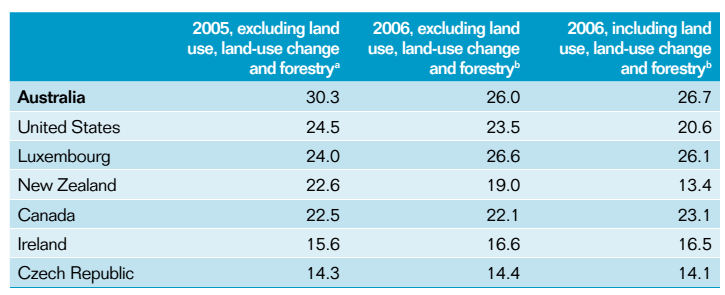
Rising of Sea Level
The rising of sea level is the major impact of climate change, which marine and coastal areas of Australia experience. Thermal expansion of oceans and melting of ice are two geological processes that cause sea levels to rise above their normal levels (Department of Climate Change 2009). Since Australia is leading in the emission of greenhouse gases, it contributes immensely to global warming. Thermal expansion of water occurs when oceans absorb heat from the environment. Global warming makes glaciers and ice caps on the mountains melt and release extra water into oceans leading to an increase in sea level. The combined effect of thermal expansion and melting of ice increases sea level and makes the coastal environment submerge.
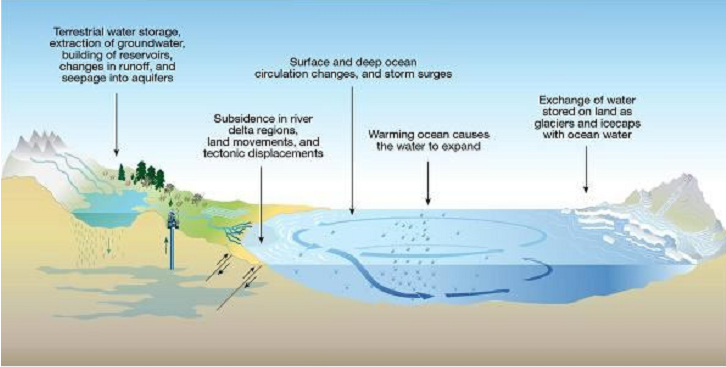
Ocean Acidification
The increasing emission of greenhouse gases such as carbon dioxide is responsible for the acidification of oceans. As Australia is leading in the emission of carbon dioxide, it causes significant acidification of ocean water. Carbon dioxide in the atmosphere dissolves in ocean water and reduces pH. The air-sea exchange of carbon dioxide creates a carbonate buffering effect, which is important in reducing the level of carbon dioxide in the air. The pH of ocean water has reduced by 0.1 units of pH since the industrial era (Newton 2009). Given that marine and coastal ecosystems require stable pH, a reduction in pH has damaging effects. A decrease in pH kills marine and coastal organisms, and thus, destroys important ecosystems. Newton (2009) asserts that low pH destroys phytoplankton and corrodes limestone and organisms with carbonates such as oysters, corals, sponges, and mollusks. Moreover, a decrease in pH reduces the concentration of oxygen in the water leading to dead organisms. Overall, acidification of ocean water causes corrosion of limestone and death of organisms, hence, destroying marine and coastal ecosystems.
Extreme Disasters
Climate change owing to global warming increases the occurrence of extreme disasters. According to Newton (2009), the notable effects of climate change are the increasing incidence and intensity of storms, flash floods, cyclones, droughts, and wave climate amongst other extreme weather events. A reduction in the atmospheric pressure in marine and coastal areas causes storms, which damages marine and coastal ecosystems. Johnson and Holbrook (2014) state that the increasing frequency and intensity of storms trigger flash floods in marine and coastal environments leading to the destruction of ecosystems and infrastructure. Department of Climate Change (2009) holds that Australia experiences cyclones owing to the increased frequency and intensity of big storms, strong winds, and heavy rainfall. Tropical cyclones destroy marine and coastal ecosystems, damage infrastructure, and displace populations. Given that a significant portion of Australia is arid and semi-arid, global warming expands desert. Destruction of marine and coastal vegetation exposes the soil, increases the rate of evaporation, decreases rainfall, and increases temperatures leading to prolonged droughts (Newton 2009). Global warming also increases the energy and frequency of waves leading to the destruction of ecosystems in marine and coastal areas. Fundamentally, climate change increases the intensity and the frequency of extreme disasters leading to massive destruction of marine and coastal ecosystems and infrastructure.
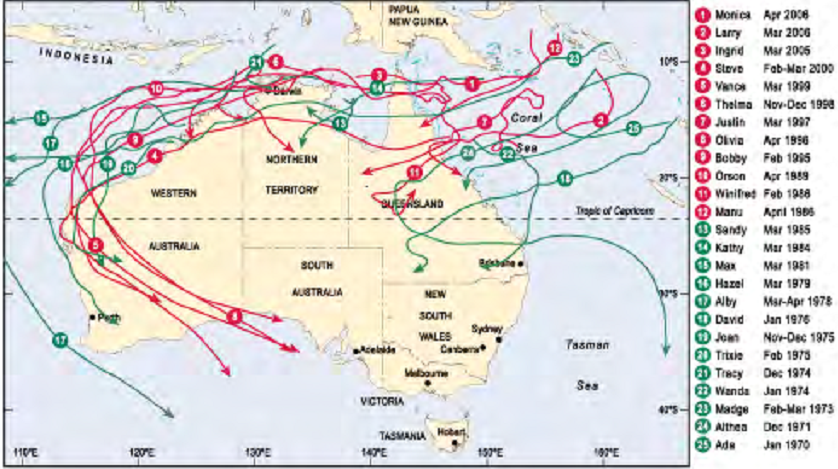
Marine and Coastal Erosion
Climate change increases the erosion of marine and coastal environments in Australia. Since global warming increases the frequency and intensity of extreme disasters, such as strong waves, floods, cyclones, strong wind, and heavy rainfall, it hastens soil erosion. According to the Department of Climate Change (2009), extreme disasters cause massive erosion of marine and coastal areas and lead to sedimentation of shorelines, estuaries, and deltas. Massive erosion affects infrastructure such as natural harbors and roads, which are central in transportation. Moreover, massive erosion destroys estuaries and deltas, which are breeding places for fishes and other organisms. Erosion in marine and coastal areas leads to the loss of fertile soil and the destruction of vegetation cover. Sedimentation also affects marine and coastal areas because it pollutes water and kills organisms. Moreover, sedimentation blocks estuaries and deltas, and thus, affects the flow of freshwater into the sea.
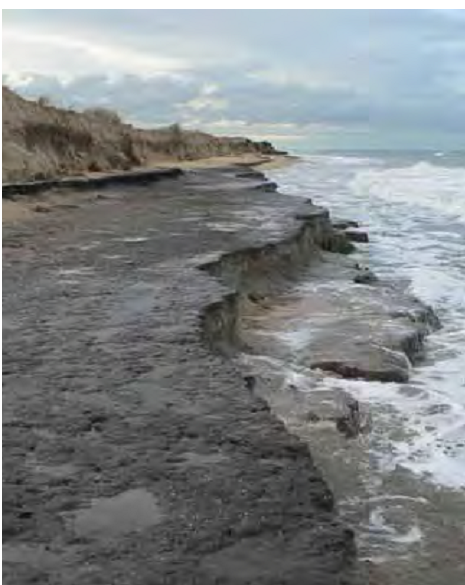
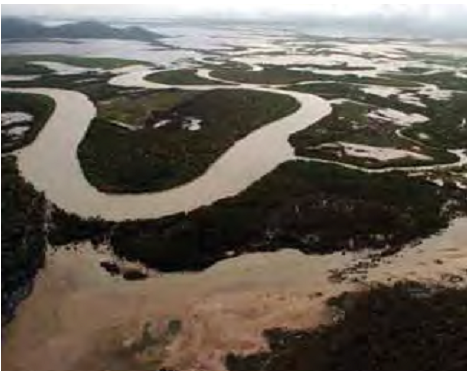
Vulnerable Ecosystems
Climate change has marked impacts on coastal ecosystems in Australia. Department of Climate Change (2009) states that climate change affects major coastal ecosystems, namely, mangroves, coral reefs, beaches, microalgae, seagrasses, and saltmarsh. Mangroves play a central role in the conservation of marine and coastal ecosystems because they decrease sedimentation, buffer waves and floods, sustain the carbon cycle, and maintain the integrity of shorelines. Furthermore, mangroves form the best habitat for marine and terrestrial animals. The coastline of Australia has the most diverse corals, which provide important habitat for fishes because they build coral reefs. Johnson and Holbrook (2014) hold that beaches, microalgae, seagrasses, and saltmarsh are other important ecosystems that maintain marine and coastal ecosystems. Rising sea levels, floods, erosion, sedimentation, waves, and other extreme disasters threaten to annihilate coastal and marine ecosystems in Australia.
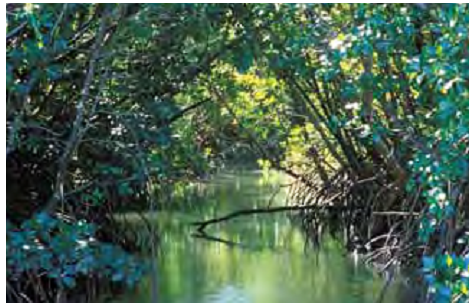
Governmental Measures to Mitigate Impacts of Climate Change
The Australian government has realized the past, present, and impending effects of climate change and has instituted several measures. Through its Department of Climate Change, the Australian government collaborates with several bodies, which have the mandate to address issues related to climate change.
- The Australian government collaborates with IPCC in reducing the number of greenhouse gases it emits.
- The Council of Australian Governments (COAG) developed a comprehensive framework, the National Climate Change Adaptation Framework, which supports the assessment of the impacts of climate change with a view to improving policy development, planning, and implementation of informed decisions.
- The Australian government through the Department of Environment advocates for the conservation of marine and coastal environments by implementing Environment Protection and Biodiversity Conservation Act (1999).
- Environmental Protection Agency is implementing policies and laws aimed at reducing air pollution by promoting the use of renewable sources of energy and minimizing the use of fossil fuels.
- The Australian government funds the establishment of renewable energy sources through the Emissions Reduction Fund (ERF) and the Australian Renewable Energy Agency (ARENA).
- The Australian government has enacted policies and legislations that support Renewable Energy Target (RET) and the use of Carbon Credit Units (CCU) in reducing the emission of greenhouse gases (Climate Change Authority 2014, para. 4).
Conclusion
Climate change poses a significant challenge to marine and coastal environments. Analysis of the geographic attributes and human activities in relation to policy, planning, and management responses indicates that Australia is unable to mitigate the impending effects of climate change. As a continent surrounded by the Indian Ocean and the Pacific Ocean, Australia has increased the risks of sea-level rise, acidification of the ocean, extreme disasters, and erosion and sedimentation leading to the destruction of marine and coastal ecosystems. Since Australia is leading in the emission of greenhouse gases, it increases its vulnerability to climate change. Overall, Australia is yet to experience massive impacts of climate change, which will affect marine and coastal environments.
The Australian government has instituted several measures to mitigate the impacts of global warming. These measures include reduction of greenhouse emissions, development of comprehensive adaptation framework, conservation of marine and coastal environments, and implementation of policies and laws. Given that Australia emits the highest amount of greenhouse gases, it predisposes itself to high risks of climate change. Moreover, Australia has a high risk of the effects of climate change because oceans surround it. Therefore, given the scale of risks and current mitigation measures, the Australian government has not prepared itself well in terms of policy, planning, and management responses. In this view, the Australian government needs to reduce carbon emissions considerably to alleviate global warming. Additionally, the Australian government should conserve coastal and marine ecosystems because they cushion them from the effects of global warming such as sea-level rise, floods, waves, and storms. International collaboration is also necessary to enhance concerted efforts aimed at mitigating global warming and climate change.
References
Climate Change Authority 2014, Australia’s greenhouse gas emissions-targets and Progress review, Australian Government Publishing Services, Canberra, Web.
Department of Climate Change 2009, Climate change risks to Australia’s coast, Australian Government Publishing Services, Canberra, Web.
Garnaut, R 2010, Australia’s emissions in a global context, Web.
Hinrichsen, D 2014, The Atlas of Coasts and Oceans, Earthscan Publications, London.
Johnson, J & Holbrook, N 2014, ‘Adaptation of Australia’s Marine Ecosystems to Climate Change: Using Science to Inform Conservation Management’, International Journal of Ecology, vol. 1, no. 2, pp. 1-12.
Newton, G 2009, ‘Australia’s environmental climate change challenge: Overview with reference to water resources’, Australasian Journal of Environmental Management, vol. 16, no.1, pp. 130-139.